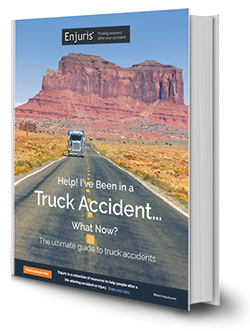Hablamos español.
Guide to commercial truck accidents involving 18-wheelers and tractor trailers—and how they differ from car accidents
Large trucks can weigh as much as 80,000 pounds, which is around 20 times more than the average car. Even at speeds as low as 10 miles per hour, a collision with a large truck can cause catastrophic injuries.
In this article, we’ll look at truck accidents in Texas, the federal and state laws governing large trucks, and the steps you can take if the unthinkable happens and you’re involved in an accident with a big rig.
What vehicles are considered trucks?
In Texas, a “truck” is defined as any motor vehicle used primarily to transport items or property. In some cases, the specific characteristics of the truck (such as the weight of the truck or the items being transported) determine whether a particular law applies.
In general, when people refer to “truck accidents,” they’re referring to crashes involving large commercial trucks, like:
- Delivery trucks
- 18-wheelers
- Oil and gas trucks
- Semi-trucks
- Big rigs
- Tractor-trailers
- Box trucks
- Dump trucks
- Tow trucks
- Refrigerated trucks
Truck accident statistics
According to the National Highway Transportation Safety Administration (NHTSA), 4,761 people were killed in crashes involving large trucks (defined as trucks with a gross vehicle weight rating greater than 10,000 pounds) in 2017.
Of all the people killed, only 18% were actual truck occupants. The vast majority of people (72%) were occupants of other vehicles, and 10% were nonoccupants (pedestrians, bicyclists, etc.).
As with car accidents, Texas ranked 1st with respect to the number of large trucks involved in fatal crashes (621) in 2017, as well as the number of truck occupants and occupants of other vehicles that were killed.
In terms of property damage, the number of large trucks involved in property-damage-only crashes in 2017 was 363,000.
Causes of truck accidents
A number of factors can cause large truck accidents. Common causes and contributing factors of truck accidents include:
- Driver fatigue
- Speeding
- Ignoring traffic regulations
- Improperly loaded cargo
- Driving under the influence of drugs or alcohol
- Lack of training and safety programs for drivers
- Inadequate inspections
- Improper maintenance
- Poor weather conditions
- Distracted drivers
It’s worth pointing out that commercial trucks need considerably more time to stop than regular cars. A regular car weighing 4,000 pounds and traveling 65 miles per hour needs approximately 316 feet to stop. In comparison, a tractor-trailer weighing 80,000 pounds needs roughly 525 feet to stop.
Laws governing truckers and trucking companies
Both federal and state laws establish certain standards that trucking companies and drivers must meet.
The relevant federal laws can be found in Title 49 of the Code of Federal Regulations. These regulations (sometimes called the Federal Motor Carrier Safety Regulations) are extensive and cover topics including:
- Driver qualifications
- Truck operation
- Vehicle repairs and maintenance
- Minimum insurance coverage
- Weigh stations
- Roadside inspections
- Compliance reviews
- Complaint investigations
- Trucking terminal audits
In addition to the federal laws that must be followed, commercial drivers in Texas must comply with various state laws. The bulk of these laws, which address many of the same items addressed in the federal laws, can be found in Title 7 of the Texas Transportation Code.
| Federal Hours of Service Limitations for Commercial Motor Vehicle Drivers | ||
|---|---|---|
| Work | Property-Carrying Vehicles | Passenger-Carrying Vehicles |
| On-Duty | Maximum 14 consecutive hours on-duty following 10 consecutive hours off-duty | Maximum 15 hours on-duty following 8 consecutive hours off-duty |
| Driving Time | Maximum 11 hours of driving during the 14-hour on-duty period | Maximum 10 hours of driving following 8 consecutive hours off-duty |
| Weekly | Maximum 60 hours on-duty in any period of 7 consecutive days (if vehicle operates every day) or maximum 70 hours on-duty in any period of 8 consecutive days (if vehicle doesn’t operate every day) | Maximum 60 hours on-duty in any period of 7 consecutive days (if vehicle operates every day) or maximum 70 hours on-duty in any period of 8 consecutive days (if vehicle doesn’t operate every day) |
Establishing liability for a truck accident
If you’re injured in a truck accident, you may be able to receive compensation for your injuries if you can establish that someone else was at fault for the accident. In most cases, the other person at fault is the truck driver, but not always.
Potential at-fault parties include:
- The truck driver. The truck driver may be at fault if their negligence caused the accident. Common examples include distracted driving, falling asleep at the wheel, and running a red light.
- The trucking company. The trucking company may be at fault (or partially at fault) if they violated a federal or state law (such as requiring the truck driver to drive for a longer period than permitted) or if they’re guilty of a negligent hiring (for example, if a company hires a driver with a history of distracted-driving accidents).
- The cargo company. One common cause of truck accidents is overloaded or improperly loaded cargo. In these situations, the cargo company may be at fault.
- The manufacturer. Truck accidents may be caused by a defective vehicle (such as an improperly designed trailer hitch that causes the trailer to come loose). In these situations, the manufacturer of the defective product might be at fault.
It’s possible that the trucking company will be held liable for the negligence of the truck driver under the theory of respondeat superior. "Respondeat superior" is a legal theory that holds a company responsible for a traffic accident caused by a truck driver so long as the truck driver is an employee and was acting within the scope of their employment.
Sometimes, both you and the truck driver (or some other party associated with the truck) are at fault for the truck accident.
So what happens then?
Texas follows what is called modified comparative fault. This means that the degree to which you may recover damages is limited to your degree of fault. What’s more, if you’re more than 50% at fault, you can’t recover any damages.
Statute of limitations
In most cases, the statute of limitations in Texas to file a civil claim is 2 years from the date of the accident.
However, in some cases (such as when the government is involved), the statute of limitations is much shorter. If you’ve been injured in a truck accident, don’t hesitate to contact an attorney.
Damages that can be recovered in a truck accident
Trucks can legally weigh up to 80,000 pounds. When that much weight is involved in a collision, the impact can be devastating. Common truck accident injuries include:
- Traumatic brain injuries
- Neck and back injuries
- Spinal cord injuries
- Broken bones
- Lacerations
- Burns
- Death
Texas awards both economic and non-economic damages in truck accident cases. “Economic damages” refer to the losses that can be easily calculated (such as medical expenses and lost wages).
“Non-economic damages” refer to losses you can’t easily put a price tag on (such as pain and suffering).
In addition, Texas awards punitive damages in cases where the defendant acted with actual malice or gross negligence. For example, punitive damages may be awarded if the truck driver who caused the accident was driving while intoxicated.
What to do after a Texas truck accident?
A motor vehicle accident can be traumatic and overwhelming. This is especially likely when the vehicle involved is a large truck. However, it’s important to remain focused and take several steps to ensure that you ultimately receive the compensation you deserve.
Step 1: Seek medical attention
The most important thing you can do following a truck accident is seek medical attention. While this might seem obvious, many people avoid seeing a doctor because they don’t believe their injuries are severe enough to warrant a trip to the hospital.
However, for many injuries, the full extent of the injury doesn’t become apparent until days or even weeks after the accident. What’s more, failing to go to the hospital after a truck accident raises a red flag to insurers, attorneys and the court.
Don’t just go to the hospital though. Be sure to keep track of all your medical expenses, as well as your aches and pains. Keeping good records will increase your chances of recovering the compensation you deserve.

Sample accident journal/diary to help you document the effect on your daily life
Download in PDF format

Damages worksheet to track expenses for your injury claim (medical treatment, property damage, lost wages, prescriptions)
Download in PDF format
Step 2: Gather and preserve evidence
Depending on the nature of your injuries, you want to begin collecting evidence as soon as possible. This means you should call the police after the accident so an officer can come to the scene and write an accident report.
In addition, you’ll want to get the truck driver’s contact information and the contact information for any witnesses.
You should also take pictures of any damages or injuries suffered as soon as possible.
Step 3: Contact a Texas truck accident attorney
Time is of the essence after a truck accident. Vital evidence such as the truck’s black box, GPS data, and driver’s logs has a tendency of going missing. That evidence is often critical to winning your truck accident lawsuit.
Just minutes after an 18-wheeler hits you, you can bet the trucking company will be working to prove they’re not at fault. Your Texas personal injury attorney needs to start gathering evidence and talking to witnesses before it’s too late.
Use our free online directory to locate and contact an experienced Texas attorney right away.
Sources
National Highway Transportation Safety Administration, Traffic Safety Facts
Texas Legislature, Title 7 of the Texas Transportation Code
Electronic Code of Federal Regulations, Title 49 of the Code of Federal Regulations
Did you know that truck accident law varies by state?
What does an injury lawyer do?
A personal injury lawyer helps individuals who have sustained injuries in accidents to recover financial compensation. These funds are often needed to pay for medical treatment, make up for lost wages and provide compensation for injuries suffered. Sometimes a case that seems simple at first may become more complicated. In these cases, consider hiring an experienced personal injury lawyer. Read more
Need a lawyer?
Hablamos español.















